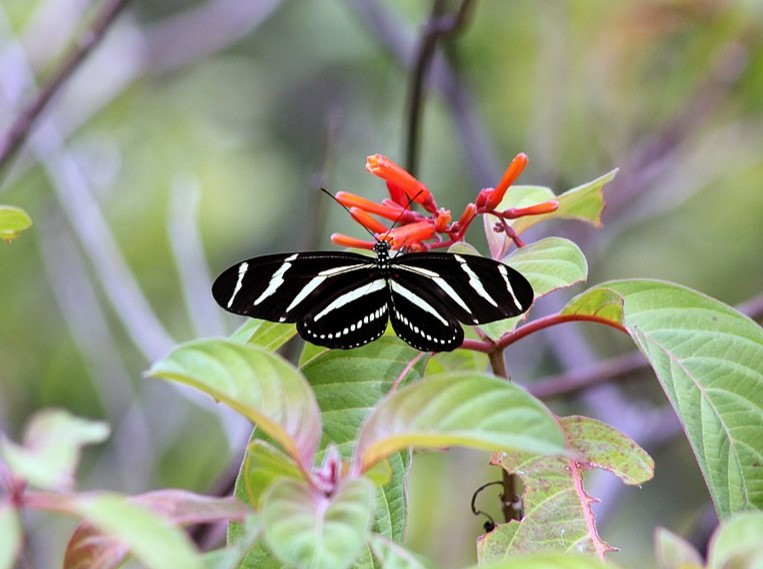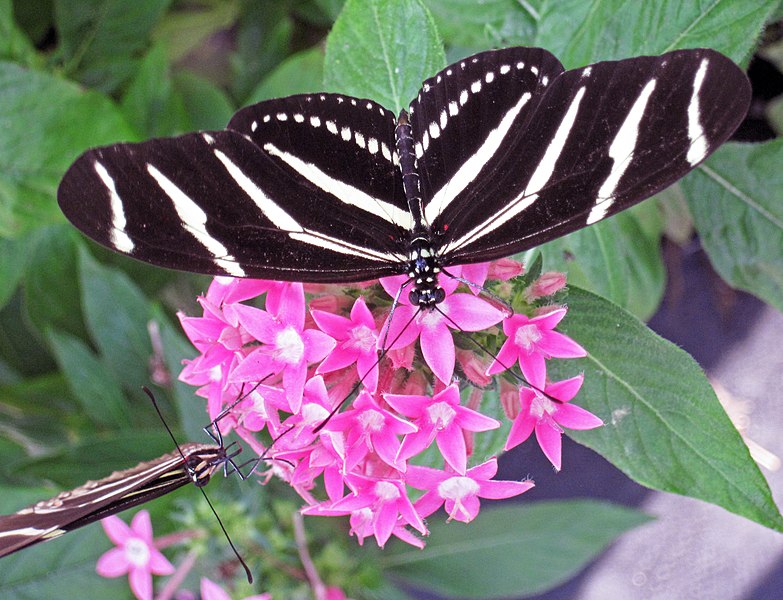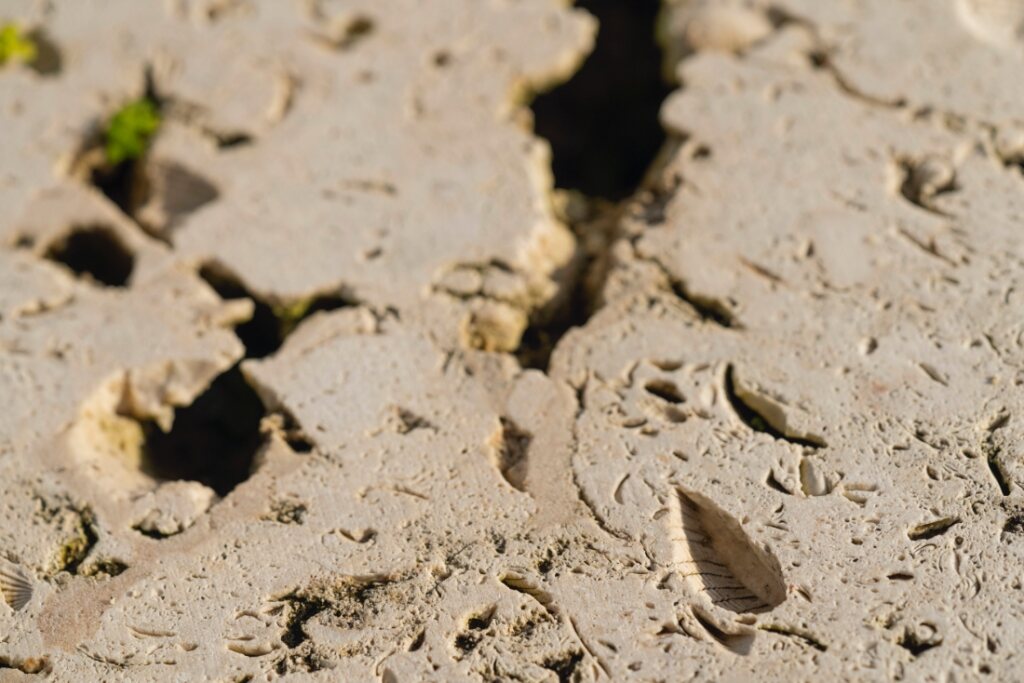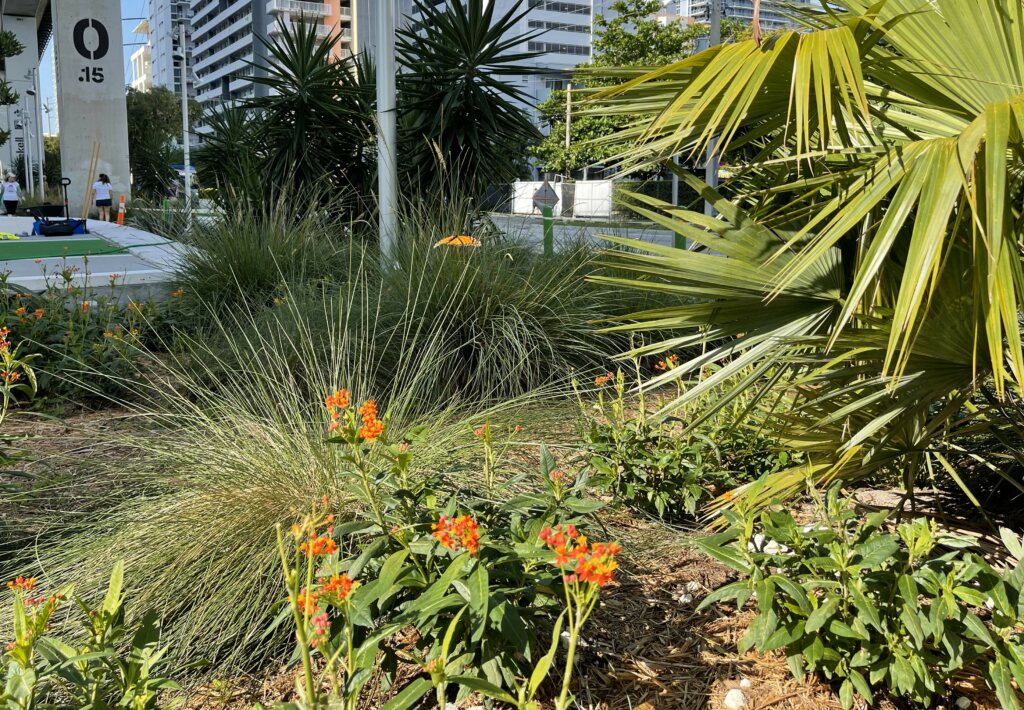Oolite Room
between SW 13th St and Brickell Metromover
Welcome! Keep your eyes peeled for fossils, you are surrounded by some of Miami’s oldest residents!

The Heliconias
Here in the Oolite Room, you can spot three native butterflies– we are the Zebra Longwing (Heliconius charithonia), Julia (Dryas julia), and Gulf Fritillary (Agraulis vanillae). We are all members of a group of butterflies called the Heliconias, so the three of us are like cousins. We look similar in size and shape, but we have a few ways you can tell the difference between us. Julias have beautiful orange wings and look almost like leaves. Gulf Fritillaries are also orange but have a black chain pattern along the edges of their wings. They also have pretty white spots you can see when our wings are closed and black spots on their upper wing areas.
Zebra longwing butterflies are the easiest to find. Can you guess which animal they look like? That’s right, a zebra! These butterflies are covered in stripes, but instead of black and white, they have black and yellow stripes. And guess what? Our caterpillars look like little aliens with spiky white or orange bodies and black spots. Take a look around and see if you can find us munching away on leaves. And then look up and see if you can spot us as butterflies. We fly a bit slower than other butterflies so it is easy to see us gently gliding by. But be careful to look at us with your eyes only! Catching us with your hands hurts our delicate wings.

We Heliconians all love the Oolite room because it has our two favorite foods– Corkystem passion vines (Passiflora suberosa) and firebush flowers (Hamelia patens)! Firebush has delicious nectar that is a favorite for butterflies, bees, and even hummingbirds. It also has lots of pollen, which we love! All butterflies drink nectar, but we Heliconians like to eat pollen as well. Nectar is mostly sugar, but pollen is full of vitamins and protein. Pollen gives us the strength to live a long life. Did you know, most butterflies only live for a week or two, but we live for several months!
Passion vines (Passiflora spp.) of all species are the food that our caterpillars eat the most, and where we lay our eggs. Passion leaves might be lunch for caterpillars, but they don’t taste good to humans and other animals. Instead, humans love passion vines for their beautiful flowers and their delicious fruit. Purple passionflower (Passiflora incarnata) has a round yellow fruit that is super tasty. You may know it as Maracuya, grenadya or passion fruit. It is used to make a juice that is sweet and sour and bien rico, it is sooooo yummy! Plant these at home and you can have delicious fruit and give home to three different beautiful butterflies!
Fun Fact: We have slumber parties!
Zebra Longwings like to sleep in big groups at night. We may spend the day flying around by ourselves, but when it starts to get dark we like to stay close to each other. Each evening many of us will meet at the same place, sometimes all on the same branch. There can be 5, 10 or even 100 of us all sleeping together, like a big sleepover party. Doesn’t that sound fun?! Who is bringing the popcorn?

Host Plants and Nectar Plants
You may have noticed that caterpillars and butterflies do not eat the same foods. Just like you ate different foods when you were a baby, caterpillars are like the baby stage of butterflies and need special food for that part of their life. Caterpillars have chewing mouthparts and like to eat leaves, stems, and flower parts. But butterflies have different mouths, and cannot chew.
Butterflies don’t even have teeth. Instead, butterflies have something called a proboscis. It’s like a long straw, and they use it to suck up the sweet sugary nectar that is deep inside of flowers. In order for butterflies to have food for all phases of life, they need both “host plants” and “nectar plants”.
“Host plants” are the plants that butterflies lay their eggs on and where their caterpillars will spend the first weeks of their lives. They are like their specialized baby food to help them grow big and strong for their next stage of life as butterflies. Caterpillars have very specific needs for their diet, and each species of caterpillar has a specific plant species (or group of species) that they can eat. Heliconia caterpillars eat passion vines, Atalas eat Coontie, Sulphurs eat Senna, and Monarchs eat Milkweed. It is those specific host plants that the mother butterflies will lay her eggs on to make sure her new caterpillars will have all the food they need as soon as they hatch. Because of this specific relationship, host plants are incredibly important to the survival of butterflies.
“Nectar plants” are the plants that butterflies use as their food source. They are like a butterflies’ favorite juice bar. And nectar is like an energy drink that gives them fuel for their active flying lives. When butterflies visit nectar plants, they pollinate the flowers and spread the pollen around, helping other plants to grow and make new flowers. Butterflies can take nectar from many different types of flowers, so they have lots of options.
Each butterfly species has a special relationship with its host and nectar plants. They need those plants to survive. That is one of the reasons why it is so important to use native plants in our gardens!
Also, to protect caterpillars and adult butterflies, it is essential to avoid using pesticides on these plants. You may choose natural environmentally friendly gardening practices instead.
This is very important to consider when you are making a pollinator garden. You want to make sure you are planting food for caterpillars and for butterflies too! The next time you see holes in the leaves of your plants, be happy! You might be providing habitat for native butterflies! look around for caterpillars.
The Miami Rock Ridge

Look around to your left and right and you will see the rocky walls of oolitic limestone. These are the remains of the Miami Rock Ridge. The Miami Rock Ridge is a continuous limestone outcrop which used to extend across much of South Florida from about Little Haiti to the upper Florida Keys and southwest into Everglades National Park. Today you can see fragments of it here, in Alice Wainwright Park and in Coconut Grove along the west side of South Bayshore Drive.
These are some of the highest natural elevations in our city, up to 23 feet, or 7 meters, above sea level in some places. That’s right, you’re looking at Miami’s “mountains” right here.
Oolitic limestone makes up the Miami Rock Ridge, and also makes up the bedrock of our city. But what is it? Oolitic limestone is a sedimentary rock formed from fossils of the sea. It is made up of tiny balls of calcium carbonate called “ooids”. When shells and fish bones decompose in the ocean they turn into calcium carbonate dust. That dust settles on the sandy ocean floor and with the action of waves, it gets rolled into little balls. Millions of years ago the ocean used to cover most of Florida. When the sea level receded (also millions of years ago) it exposed layers and layers of these ooids as well as ancient coral reefs, oyster beds, and the skeletons of fish and mollusks from ages ago. Once exposed, the acidity of rain began to dissolve and fuse these ooids into a solid mass combining the fossils of ancient corals and sea creatures.
Something fascinating about Oolite is that it also contains visible fossils of corals, sea urchins, and mollusks. Take a closer look at the Oolite outcrop here and see what cool fossils you can spot!
Fun fact: The word ooids comes from the Greek word “ooides,” which means “resembling an egg”.
